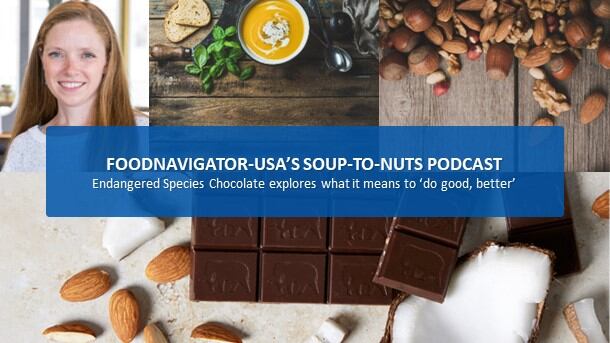But while the company’s efforts are admirable – and impactful as illustrated by its ability to give more than $3.1 million to its global partners since 2016 – ESC leadership two years ago asked itself if its approach to “doing good” was good enough? And the answer, surprisingly – and perhaps a bit painfully – was no.
The realization that the company’s “big hairy audacious goal” set in 2016 of giving $1 million back to conservation annually wasn’t as inspirational as it once was forced ESC on a “soul searching journey” that Chief Revenue Officer Whitney Bembenick says unlocked a new vision. She explains in this episode of FoodNavigator-USA’s Soup-To-Nuts podcast how ESC’s revised mission to “see joy through abundant giving” and to “do good, better” led the company to adopt a new marketing strategy, inspired a suite of innovations and led to additional retailer support to expand distribution with the ultimate goal of giving more by doubling the business.
[Editor’s note: Never miss an episode of FoodNavigator-USA’s Soup-To-Nuts podcast – subscribe today.]
‘Doing good, better’ by looking for ‘joy through abundant giving’
When Endangered Species Chocolate launched in 1993, the idea of creating a sustainable, natural, great-tasting chocolate and donating a significant portion of the profits to a good cause was a novel business model.
But as the idea that a business could grow and succeed by “doing good” expanded and was adopted by more companies, Bembenick said ESC leadership began to feel “complacent” and that the company needed to do something new to stand out, increase its impact and better connect consumers to its mission.
“The company was founded on two passions: one for great chocolate and the other for conservation,” and to support the latter, the company has earmarked donating annually 10% of its profits for its Give Forward campaign, Bembenick said.
She explained that while those values haven’t changed, in recent years the company found itself wanting to do and give more, and to do that it needed to look inward and create a mission that inspired employees and consumers and which the company “could live a breathe.”
Bembenick explained the company’s existing donation goal “wasn’t much of a vision statement. It was a ‘big, hairy, audacious goal,’” that was aspirational but not necessarily a driving force for consumers.
“So, we took a soul searching journey,” and identified the company’s core values were to serve, to give and to cultivate others, which it wove into a new mission statement “to see joy through abundant giving” and by using restorative business practices to do good, better, Bembenick explained.
ESC identifies innovation as essential for driving business and giving more
One way Bembenick says Endangered Species Chocolate plans to meet this “audacious” goal of doubling the business so it can inspire joy through abundant giving is through new product development, including seasonal innovation, as well as filling what Bembenick calls unmet “jobs” within the chocolate category.
She explains that consumers go down grocery aisles or explore categories because they are looking for products that can do a job for them, and the core jobs for the chocolate category are to offer a convenient indulgence or reward at the end of a hard day, with a cup of coffee or in the afternoon as a pick-me-up, among other reasons.
As consumers became more aware of their health, they also looked for chocolate that could support their wellbeing – maybe with functional benefits or less sugar or with in other ethical or dietary parameters.
Chocolate’s third job – and “an easy layup for anybody doing innovation” – is to offer a new experience, Bembenick said.
From there, she said, ESC brainstormed ideas and conducted qualitative and quantitative studies to create new products that consumers want, need and will buy.
This process inspired the recent and upcoming launch of nearly 20 new products, which Bembenick explains tapped into consumers’ desire for indulgent, yet better-for-you, chocolates made with ingredients and in a way they can feel good about. The innovations also address consumer concerns about packaging as well as their desire for higher-quality, fun and snackable products.
ESC ties its approach to innovation with its mission of “seeing joy through abundant giving” by making space for consumers to engage with its products on different levels – whether that be as an eating experience, a way to learn more about or support conservation or to support sustainability and farmers around the world.
ESC expands sales team to support increased distribution
The second way ESC plans to double its business to give more is by expanding its distribution – including through its partnership with Walmart, which Bembenick says is possible thanks in part to adding a dedicated sales team member to focus on large accounts.
“One big shift that we made just this year is we have a dedicated resource on our sales team to our largest accounts, and she has no other responsibilities other than serving the key customers,” said Bembenick, who added it is a detail-oriented and essential job.
ESC gives to 30 charities to celebrate 30 year anniversary
As the company expands its portfolio and distribution, it is also expanding its giving – including to 30 charities in 2023 to mark its 30th anniversary. Bembenick explains that ESC is more aggressively telling the story of its giving – and the impact of its donations – to mainstream consumers so that they better understand how their purchase is “doing good.”
Looking forward to the next three years – if not the next 30 – Bembenick says ESC will continue to innovate and expand distribution as it strives to double its business so that it can further support conservation and more consumers can experience joy through abundant giving.

